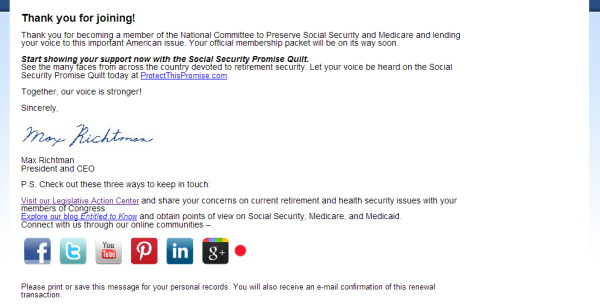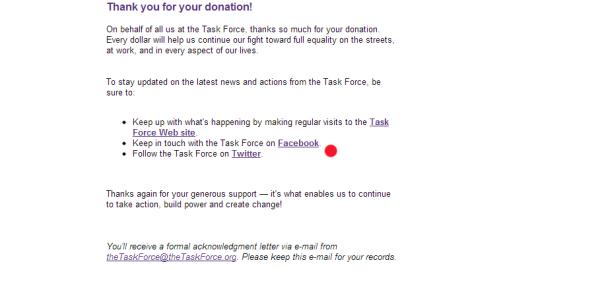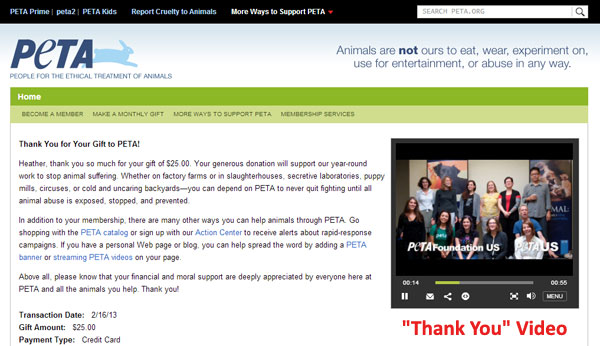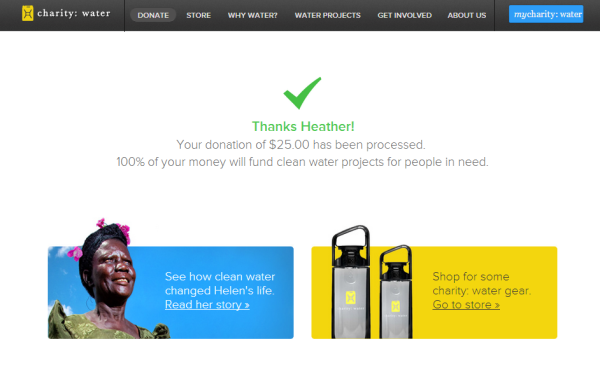Fundraising Best Practices: Sharing the Results of Donating Online to 31 Nonprofits
 Each year I select 31 Favorite Nonprofits to which I donate 10% of my webinar income. Part of the reason is a commitment to altruism, but I also use (for lack of a better word) these 31 nonprofits to study how nonprofits are progressing in online fundraising, social media and mobile communications. That said, over the last few days I donated $25 to each of this year’s 31 Favorite Nonprofits and was dismayed to see that most of the nonprofits are not successfully integrating social media and mobile communications into their “Donate Now” process. I realize, however, that much of the reason is due to limitations imposed by the “Donate Now” service provider that they are using. As a result, the online donation process for most of these nonprofits seems to be stagnating and stuck in the best practices that ruled in 2006. For that reason I am actively seeking leads on “Donate Now” service providers that are innovating and keeping up with technology so I can promote them to nonprofits in my blog and webinars.
Each year I select 31 Favorite Nonprofits to which I donate 10% of my webinar income. Part of the reason is a commitment to altruism, but I also use (for lack of a better word) these 31 nonprofits to study how nonprofits are progressing in online fundraising, social media and mobile communications. That said, over the last few days I donated $25 to each of this year’s 31 Favorite Nonprofits and was dismayed to see that most of the nonprofits are not successfully integrating social media and mobile communications into their “Donate Now” process. I realize, however, that much of the reason is due to limitations imposed by the “Donate Now” service provider that they are using. As a result, the online donation process for most of these nonprofits seems to be stagnating and stuck in the best practices that ruled in 2006. For that reason I am actively seeking leads on “Donate Now” service providers that are innovating and keeping up with technology so I can promote them to nonprofits in my blog and webinars.
All that said, when I donated to the 31 nonprofits there were eight basic criteria I was looking for in the donation process. I am not sure how useful this information is to nonprofits. By no means is this a scientific study with a large pool of data, but at the very least you can compare your nonprofit’s “Donate Now” process to this year’s 31 Favorite Nonprofits which range from small, local nonprofits to large, international nonprofits.
1) The “Donate Now” button was prominently featured on the nonprofit’s home page requiring only 2-3 seconds to locate.
Results: 28 of the 31 nonprofits had very easy to find “Donate Now” buttons (or text-based links) on the home page. The best buttons were those that were a bright color and grabbed my attention immediately. The three nonprofits that did not have “Donate Now” buttons on their home page buried the process under tabs or pop-downs menus entitled “Support Us” or “How You Can Help” which for some donors may cause frustration. Also, for the record, I am definitely an advocate of using a “Donate Now” button over a text-based link.
2) If the “Donate Now” process was embedded inside of the nonprofit’s website i.e., the donor was not sent to a third-party website where the donor had to sign up or join the third-party website to make the donation.
Results: 25 of the 31 nonprofits had the donation process entirely embedded inside their website. That’s good because recent data from Network for Good indicates that 6X more money is raised through branded “Donate Now” pages.
3) How many pages I had to click through to complete the donation.
Results: I am believer that some donors will drop out of the donation process if it is overly complicated or time-consuming. Muchos kudos to the nonprofits that kept the donation process limited to one or two pages with only minimal data required to donate (name, mailing/billing address, and credit card information). After clicking the “Donate Now” button:
13 of the 31 nonprofits enabled donors to complete the donation process on one page.
10 of the 31 nonprofits enabled donors to complete the donation process in two pages.
3 of the 31 nonprofits enabled donors to complete the donation process in three pages.
1 of the 31 nonprofits enabled donors to complete the donation process in four pages.
1 of the 31 nonprofits enabled donors to complete the donation process in five pages.
1 of the 31 nonprofits enabled donors to complete the donation process in six pages.
1 of the 31 nonprofits enabled donors to complete the donation process in seven pages
1 of the 31 nonprofits enabled donors to complete the donation process in nine pages.
4) If the nonprofit had a default donation amount set on the “Donate Now” page.
Results: A few years back I read a study that claimed that a $25 default donation amount results in more money raised online. I can’t find the study now, but my instinct tells me that choosing an amount that isn’t too small or too large has impact on the total amount a nonprofit raises online. Whether not having a default donation amount set improves or hampers results – sorry, I don’t have that data, but Idealware has some advice on the subject. That said:
21 of the 31 nonprofits had not set a default donation amount.
1 of the 31 nonprofits had set a $10 default donation amount.
1 of the 31 nonprofits had set a $15 default donation amount.
1 of the 31 nonprofits had set a $20 default donation amount.
2 of the 31 nonprofits had set a $25 default donation amount.
1 of the 31 nonprofits had set a $50 default donation amount.
1 of the 31 nonprofits had set a $100 default donation amount.
1 of the 31 nonprofits had set a $1,000 default donation amount.
5) If the nonprofit required a phone number to make the donation.
Results: Some donors will drop out of the donation process if they think the nonprofit will start calling them asking them to donate more. I know until I got the idea to enter a fake phone number, I would often drop out of the donation process if a phone number was required. That said, 18 of the nonprofits did not require a phone number to make on online donation. 13 did.
6) If the “Thank You for Your Donation” landing page included social networking icons or pitches to “Like” or “Follow” or “Join” the nonprofit on the Social Web and/or a “Thank You” video or slideshow.
Results: These are the results that broke my heart, figuratively speaking. Only four of the 31 nonprofits had added social networking icons or a social media pitch to their “Thank You for Your Donation” landing page and only one nonprofit had a “Thank You” video.
Social Networking Icons on the “Thank You for Your Donation” Landing Page
National Campaign to Protect Social Security & Medicare
Social Media Pitch on the “Thank You for Your Donation” Landing Page
National Gay & Lesbian Task Force
“Thank You” Video on the “Thank You for Your Donation” Landing Page
People for the Ethical Treatment of Animals (Peta)
7) If the follow-up “Thank You for Your Donation” email included social networking icons or pitches to “Like” or “Follow” or “Join” the nonprofit on the Social Web and/or a “Thank You” video or slideshow.
Results: Only five of the 31 nonprofits included social networking icons or pitches to “Like” or “Follow” or “Join” their nonprofits on the Social Web in their follow-up “Thank You for Your Donation” email. None included a “Thank You” video or slideshow. That said, only two of the 31 nonprofits had the icons or pitch on both their landing pages and in their follow-up emails:
Social Networking Icons in the Follow-Up “Thank You for Your Donation” Email
National Campaign to Protect Social Security & Medicare
Social Media Pitch in the Follow-Up “Thank You for Your Donation” Email
National Gay & Lesbian Task Force
8) If the donor was prompted to opt-in to receive text alerts (if applicable) from the nonprofit during the “Donate Now” process.
Results: Only one of the 31 nonprofits had included an opt-in to subscribe to receive text alerts during the “Donate Now” process. That said, I am only aware of two of the 31 nonprofits that are utilizing text messaging in their mobile communications and fundraising strategy.
Text Alert Opt-In During “Donate Now” Process
10×10 Campaign
Other findings:
* Only one of the 31 nonprofits had all of the above – the National Campaign to Protect Social Security & Medicare, but full-disclosure – that’s likely because we worked together on a social media audit in 2012. The NCPSSM is very familiar with my advice on the subject. Runner-ups were charity: water and Peta.
* The donation process for two of the 31 nonprofits didn’t work. For some reason my donations were immediately refunded by my credit card company. Yikes. This could have been happening for days or weeks which is why it’s important for a nonprofit to donate $10 to itself at least once a month to make sure the donation process is working correctly.
* Four of the 31 nonprofits were using PayPal which can be problematic. Some donors are confused when they are prompted to create a PayPal account to make a donation. It’s not actually a requirement to create a PayPal account to donate, but PayPal hides that fact a bit. They have a vested interest in donors creating PayPal accounts. PayPal is inexpensive, but it’s tool set is very limited.
* Finally, an honorable mention for design goes to charity: water. The vast majority of “Thank You for Your Donation” landing pages and follow-up emails lack visuals and are overloaded with text and white space. Not the case with charity: water. Since their launch in 2006 they have always understood and mastered the power of good design:
charity: water “Thank You for Your Donation” Landing Page
charity: water Follow-Up “Thank You for Your Donation” Email
Related Links:
Webinar: Online Fundraising and e-Newsletters for Nonprofits
Seeking Feedback from Nonprofits: Does This “Donate Now” Service Provider Exist?
Trackbacks
- Best practices for online giving | The Wired Nonprofit Class 2013
- Fundraisingwoche vom 11.-17.02.2013 | sozialmarketing.de - wir lieben Fundraising
- Fundraising Best Practices: Sharing the Results of Donating Online to 31 Nonprofits (via nonprofit tech 2.0) « Mission-Minded Media
- Fundraising Best Practices: Sharing the Results of Donating Online to 31 Nonprofits | Websites for Charities | Scoop.it
- Social Media Storytelling + the Donate Button | Nonprofits of Austin + Social Media
- Les meilleures pratiques de collectes de fonds : les résultats des collectes en ligne de 31 acteurs non profit | Marketing caritatif web et social média | Scoop.it
- Tips For Successful Online Donation Processes | Technology and Marketing of the Arts
- The Math and Science of Social and Mobile Media: A Spreadsheet to Track Your Fundraising Success | Nonprofit Tech 2.0 Blog :: A Social Media Guide for Nonprofits













Thanks Heather for this summary of real life experience. There is no substitute for the real life experience of following through on making the donation. I always encourage nonprofits to also follow through what happens with the donation at their office. For some small nonprofits there can also be surprises there if it is handled in different routes than a check that comes in the mail.
Marion
Nice post! I love that you do this systematically every year and include several examples of things that are working well.
I particularly like how Charity Water reinforces the donor’s commitment by immediately showing them evidence of how their gift is used (Helen’s story on thanks page).
Most of this is stuff any organization could do, even the tiniest, using inexpensive or free tools. So important to put yourself in the donor’s shoes and test your own system!
Great article! Some of these are no-brainers, but some I would not have thought of regarding the buttons on the home page. I enjoy helping non-profits raise money through recycling, something anyone can (and hopefully already does) anyway!
This is an interesting study. I’d love to see the data about size of donations in terms of sites that use good practices like social sharing and video thank yous, against those which dont. Someone should get some grant money to make this a larger study too.
Online donation is amazing, I wish people of good heart can reach out to AICC UGANDA and thus support orphans and vulnerable children.
Wow — I agree that not-for-profits have to make it easy for donors, but this is a lot to ask those civic-minded entrepreneurs to keep up with. I guess I expect a little backwardness because they don’t have the budgets to have everything all polished and convenient, but it is troublesome when your donation doesn’t get taken!
This was very inspiring. I support Greater Chicago Cavalier Rescue. We are just learning to crawl in the social media world. Here are scores:
1) The “Donate Now” button was prominently featured on the nonprofit’s home page requiring only 2-3 seconds to locate.
GCCR: Yes
2) If the “Donate Now” process was embedded inside of the nonprofit’s website i.e., the donor was not sent to a third-party website where the donor had to sign up or join the third-party website to make the donation..
GCCR: Yes
3) How many pages I had to click through to complete the donation.
GCCR: 2 pages (enter & confirm) before PayPal kicks in (2\3 more for paypal)
4) If the nonprofit had a default donation amount set on the “Donate Now” page.
GCCR: not on the home page “You can donate in many ways”, others donations do
5) If the nonprofit required a phone number to make the donation.
GCCR: not required.
6) If the “Thank You for Your Donation” landing page included social networking icons or pitches to “Like” or “Follow” or “Join” the nonprofit on the Social Web and/or a “Thank You” video or slideshow.
GCCR: yes, they are built in by CiviCRM, at the bottom of the page. This is a selected choice on setup.
7) If the follow-up “Thank You for Your Donation” email included social networking icons or pitches to “Like” or “Follow” or “Join” the nonprofit on the Social Web and/or a “Thank You” video or slideshow.
GCCR: No, not on thank you email
8) If the donor was prompted to opt-in to receive text alerts (if applicable) from the nonprofit during the “Donate Now” process.
GCCR: No, we do not have this functionality.
Here’s another one: if the “Thank you” page includes an option to Tweet or Facebook your donation (which it should), is the pre-loaded Tweet well-constructed? Does it include the handle of the organization (good), or that of the donation-processor (bad)? Does it include an appropriate hashtag? A good call to action?
Here’s one company that’s mastered the donate button. They call it the Better Donate Button. Here’s the link: http://www.socialgoodnetwork.com/bdb.php. This solves all the issues you outlined here.
Did any of them ask donors to opt in for the newsletter?
One or two, but I have been put on the e-newsletter of all of them. I am not sure legally where that stands, but adding a donor to an e-newsletter seems reasonable enough.
Thanks for your response. We have a client that is building an enewsletter list and wondered if this would be one way to add more names to it.
Hi Heather. We use Razoo. The badge is large and prominent on our pages, and it is very user-friendly. The program also includes a mobile donate program and a Facebook page link. Downsides (relative to your criteria) is that the automatically-generated thank you letters don’t allow for social media badges, but we follow up on those ourselves.